Introduction
Auctions are an easy way to promote your organization’s mission and fundraising by allowing your donors to support your organization by bidding on and purchasing auction items. These items can be t-shirts, gift cards, vacations, etc. Auctions can be stand alone sites or they can be used in conjunction with an event.
We understand the vital role that fundraising plays in achieving your mission. Online auctions offer an innovative way to engage your supporters, foster community involvement, and raise funds more effectively than ever before.
Why Choose Online Auctions?
- Global Reach: Break down geographical barriers and extend your reach to supporters across the globe, creating a worldwide network of contributors who share your passion for change.
- Convenience: Bid from the comfort of your home or while on the go – online auctions provide flexibility that traditional auctions can't match, ensuring maximum participation.
- Engagement: Interactive bidding platforms make fundraising exciting and interactive, encouraging healthy competition among participants and driving up donations.
- Transparency: Keep your supporters informed about the progress of the auction in real-time, enhancing trust and showing the tangible impact of their contributions.
- Diverse Offerings: Showcase a diverse range of items and experiences, from exclusive memorabilia to unique adventures, catering to various interests and demographics.
- Cost-Effective: Minimize logistical costs and venue expenses associated with traditional auctions, allowing a larger portion of funds raised to directly benefit your cause.
- User-Friendly Platform: Our intuitive digital platform ensures a seamless experience for both organizers and participants, making bidding and managing the auction a breeze.
- Customization: Tailor the auction to your organization's brand and cause, creating a cohesive and personalized experience that resonates with your supporters.
- Mobile Compatibility: Reach supporters on their preferred devices with a fully mobile-responsive interface, enabling convenient bidding and engagement.
- Integrated Payment Solutions: Facilitate secure online transactions, providing ease and peace of mind to your donors.
- Integrated CRM Capabilities: Integrated auction and fundraising results which provider greater insights to your donor engagement and cultivation.
Table of Contents
Prerequisites
- If you are interested in learning more about CharityEngine's Online Auction functionality and pricing, please contact your account manager.
- Even if the organization's Auction is not associated with a specific event, please create an event for the auction.
- Please note that all dates/times for events, auctions, and auction items are presented in Eastern Standard Time.
Instructions - Creating a New Auction
Important Note: Before creating an organization's auction, make sure the user has created the event the organization will attribute the auction towards.
Creating an Event
As the first step, the user will create a new Event.
Step 1: Navigate to Events application > Events > Search & Manage > Create New

Step 2: Enter event Name as the required field.
In addition, the user can also include other attributions such as:
- Type: Select from drop down for available options
- Active: Default to Yes. Once event/auction is complete, user can toggle to No
- Region: Select organization's available region (as applicable)
- Location: If auction/event will be held in a specific geographic location, user can select as applicable
- Dates: Enter start/end dates. Please note, by entering a future date, the event will not be made available for configuration. Please update dates following auction configuration and testing
- Manager: Select person
- Website: Insert applicable external website
- Description: General organizational details
Click SAVE to secure the event details.

Step 3: Once the event has been created, additional attributions are available for the user to update as needed. Additional attributions are optional for auction set up. If interested in learning more about attributions, see our Help Center - Events & Volunteers section for details.
Creating an Auction
After creation of an Event, begin the steps to create the organization's Auction.
Step 1: Navigate to Events application > Auctions > Search & Manage > Create New
Step 2: The user will need to Name the auction as well as select the Event created above.
- Active defaults to Yes, the user should deactivate at the conclusion of the event
- Description is also available to as needed
Once the user clicks SAVE additional tabs will also populate. In addition, a QR code is also populated for usage across email, external publishing.
In addition the Link will be exposed for usage in email, texting, and other communication needs. This is the link in which constituents can access the organization's auction.

Instructions - Configuration of the Auction
Design Tab
The Design tab will allow the user to configure, images, color usage across the form. 
Page Tab
The Pages Tab will allow the user to create additional CMS pages which may be associated with the organization's auction. Example may include "About our Organization", "Event Sponsorship", "Auction Event Details". Pages will be made publicly available to visitors of the auction site.
Home
This acts as the auction landing page. Leverage the editor to add content, link, videos, images, etc. The Content Writer can be initiated to assist the user with content generation.
Click SAVE to secure changes. 
The output will be presented on the auction homepage, as displayed below.

Other
If the organization would like to include additional CMS pages to the auction site, use the Other Subtab. These CMS pages will be displayed as link throughs on the top of the auction site and remain persistent to end users while donors navigate through the auction site. 
Enter the below information:
- Name - internal CMS page name
- Active - defaults to Yes
- Category - select existing category or create new - This will be the public facing language presented to end users
- Tags - add appropriate tags for search engine
- Mode - default to Public for access to all constituent and donors - set to Private if link requires the user to log in to access the page information
- Editor Box - use this area to create and customize content, images, videos, use integrated AI feature to initiate the Content Writer

Output will be presented as persistent click throughs at the top of the auction page, as displayed below.

Navigation
The navigation feature allows one, many or no navigation options for end users.
- Nav Bar - defaults to show to activate on the auction site - toggle to hide to suppress
- Home - show allows users to easily navigate to the auction home page
- Search - show allows users to (available once user is logged in)
- Profile - show allows users to update existing auction profiles details including payment information, shipping/billing address, etc. (available once user is logged in)
- Sign Up - show allows new users to create a first time auction profile to begin bidding
- The naming convention can be customized to the organization's needs by updating the text fields to the right of the navigation option
- Note, there are character limitations
Click SAVE to secure all changes.

The navigation options will presented for auction navigation, as demonstrated below:

Sign Up
Note: Sign Up within Navigation is specific to sign up of the auction and NOT the event. If users are signing up for an event (i.e. purchase of tickets to participate in the event or dinner), the user will also need to sign up for auction participation. Conversely, a user is not required to register for an event to participate in the event's auction.
ProTip: From your Event Web Form, when a user completes their registration for an event, use the Event Email Acknowledgement Template to include a link to the auction (or the QR code from the Auction).
General
The Sign up Tab will allow you to insert any legal terms and conditions and any age restriction notations associated with the organization's auction.

Email Receipt
The Email Receipt allows the organization to customize:
- Subject - Email subject line
- Reply To - custom organization email if a donor responds to the sign up email
- Display Name - Provide the organization with the ability to enter the Email Display Name to be presented on the sign up email
Note: 
Note: Example of Email Content

Groups and Tags
To apply attributions to contact records, leverage the Groups and/or Tags. Select an existing Group/Tag and click add. Or select create to develop a new group/tag. Any new or existing contact record will receive this attribution once the constituent signs up for the organization's auction.
The Opt-In List tab will allow the organization to automatically assign any new or existing contact record to be assigned to a communication opt in list. This assignment will take place when the constituent signs up for the organization's auction.
Pro-Tip: One or more of these attributions may be helpful to identify auction participants. Leverage an attribution to target auction updates and reminders during the auction's timeline. 
Bidding
The bidding tab allows the organization to establish global auction parameters to be used within the organization's auction. While these are global parameters, some features can be customized at the item level.
General
Bid authorizations, also known as pre-authorization holds, are a common mechanism used in online auctions to ensure that bidders have the financial capability to back up their bids.
Here's how bid authorizations work in the online auction application:
- Registration/Sign Up: Bidders typically need to register on the online auction platform before participating. During registration with CharityEngine Auctions, the bidder will be required to provide payment information, such as credit card details.
- Placing Bids: Once registered, bidders can place bids on items they're interested in. When they place a bid, the auction platform checks their registered payment method to ensure it is valid.
- Bid Authorization Hold: If a bidder places a bid, the auction platform places a temporary hold on their payment method based upon the organization's setting. This value can vary between $0.01 up to the item big amount. This is done to ensure that the bidder has enough funds available to cover their bid if they win the auction.
- Validation: The bid authorization hold is a validation process and doesn't deduct the funds from the bidder's account. Instead, it sets aside a portion of their available credit or funds.
- Increments and Maximum Bids: During the auction, if someone else places a higher bid, the system will automatically increase the bid for the current bidder up to their maximum bid amount. This helps maintain the winning bidder's position without requiring them to manually increase their bid.
- Release of Holds: If a bidder is outbid or if they don't win the item, the bid authorization hold is usually released shortly after the auction ends. The funds are not actually charged, and the held amount becomes available again for the bidder's use.
- Winning Bid: If a bidder wins an item, the bid authorization hold is converted into a charge, and the actual payment is processed. The held amount is applied toward the final bid price, and any remaining balance is charged to the bidder's payment method.
For both bidders and organizers, clear communication about how bid authorizations work is crucial to avoid misunderstandings and to create a transparent and fair auction environment. Always ensure that your auction's terms and conditions clearly outline the bid authorization process and any related policies.

- Authorization Type:
- Bid Amount - authorization hold against the full bid amount of the item
- Fixed Amount - authorization hold against a fixed amount as assigned by the organization
- If Fixed Amount is selected, please complete Fixed Bid Authorization.
- A bid amount authorization in the context of online auctions refers to the process of verifying a bidder's financial ability to place bids on items in the auction. It involves temporarily holding a certain amount of funds or credit on the bidder's chosen payment method, usually a credit card, to ensure that they have the means to back up their bids if they win an item. This verification process helps prevent frivolous or fake bids and contributes to the integrity of the auction.
- Fixed Bid Authorization: If fixed bid is selected, the organization should set the fix bid authorization. A minimum fixed for this setting will default to $0.01.
- Minimum Bid Increment: A minimum bid increment is the smallest amount by which a bid must increase in an auction when a new bid is placed. It ensures that bidding remains competitive and fair, preventing participants from making tiny incremental bids that would otherwise slow down the auction process or lead to negligible increases in the bidding price.
- For example, let's say an item is currently being auctioned with a bid of $100, and the auction has a minimum bid increment of $10. If a bidder wants to place a new bid, they must bid at least $110 ($100 + $10) to be considered the highest bidder. If another bidder wants to outbid the first bidder, they must place a bid higher than $110, according to the minimum bid increment.
- A value of $0.00 sets no minimum bid increment.
- Maximum Bid Increment: A maximum bid increment is the largest amount by which a bid must increase in an auction when a new bid is placed. It ensures that bidding remains competitive and fair, preventing participants from making tiny incremental bids that would otherwise slow down the auction process or lead to negligible increases in the bidding price.
- A value of $0.00 sets no maximum bid increment.
- Show Names: The organization can elect to publicly show bidder names of auction items through the online auction.
- Note: This setting is for the global authorization of the auction. Individual auction items can be set for bid or fixed amount as well as minimum and maximum bid increments.
Note: Authorization occurs for each bid taking place during the auction event. This can apply to the same item and/or multiple auction items.
Bid Emails
In this configuration, organizations can set bidding notifications.

The Bid Email allows the organization to customize:
- Subject - Email subject line for the top bidder
- Reply To - custom organization email if a donor responds to the sign up email
- Display Name - Provide the organization with the ability to enter the Email Display Name to be presented on the top bidder notification
Email Example:

SMS/Text Example:

Links will route the bidder to the specific action item.
Outbid Emails
In this configuration, organizations can set out bidding notifications.

The Out Bid Email allows the organization to customize:
- Subject - Emai subject line for the top bidder
- Reply To - custom organization email if a donor responds to the sign up email
- Display Name - Provide the organization with the ability to enter the Email Display Name to be presented on the top bidder notification
Email Example:

SMS Example:

Items
In this section, organizations can build out associated auction items or modify existing auction items. As the auction is initiated, organizations can also monitor auction item performance.
Step 1: Click Add New

Step 2: From the General tab
- Auction - Verify proper assignment auction name
- Name - required - name of auction item (public facing)
- Active - default setting yes
- Subtitle - required - public facing subtitle
- Starting Bid - set a minimum starting bid for the item
- Show Buy It Now - allow participants to buy item before end of auction at set price
- Time Zone - Select your auction's time zone, please note default is Eastern Standard Time
- Start Date - required - set start date/time
- End Date - required - set end date/time
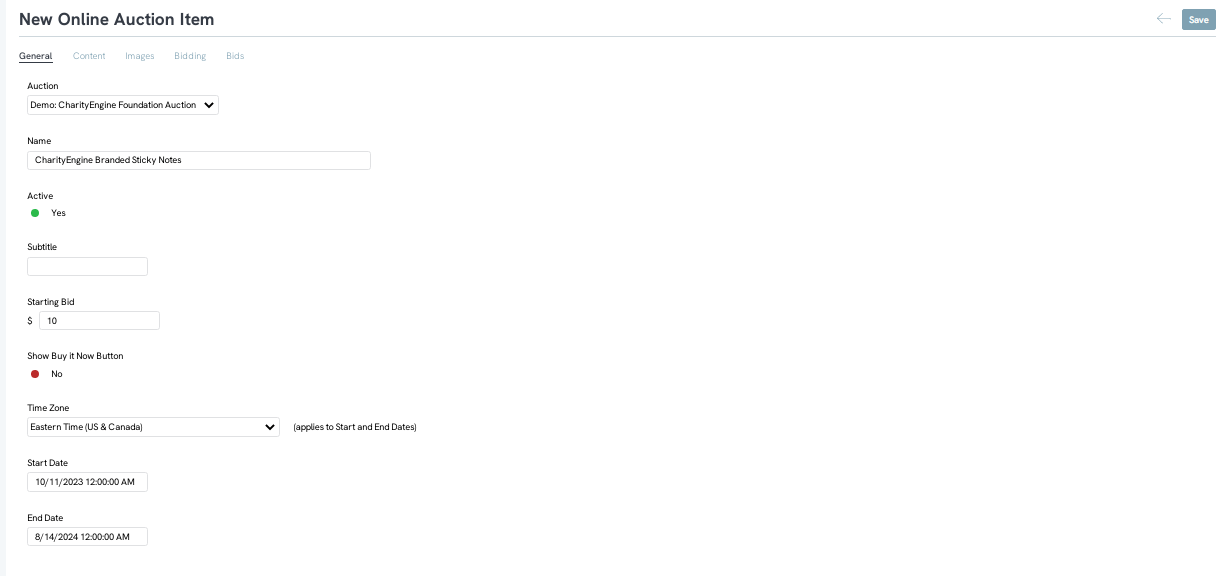
Step 3: On the Content tab, create an item description of the auction item.

Step 4: On the Images tab, upload the item images.
- Small Image: Image displays in auction item search
- Medium Image: Image displays in auction item detail page
- Large Image:

Step 5: On the Bidding tab, the user can elect to override minimum and maximum bid overrides at the item level. This overrides global settings as set in the Bidding section above.
This is useful if the item is high value and the organization wishes to ensure donors are bidding at a higher rate than the global setting.

Step 6: Click SAVE to secure the item settings.
Auction Items will be listed by line item.
Once an auction is initiated, the organization and event coordinator(s) can monitor bid totals, highest bid, end dates, and the status (Pending, Active, Inactive, Ended) of the auction item. 
Social & Contact Info
Leverage this tab to expose social media links to expose on the organization's auction site as well as sharing content.

Advanced
Developer
The Advanced tab can be used to associate the organization's auction with a pre-existing CharityEngine CMS website. Use the drop-down to select the website. Web developers can leverage CSS and/or JavaScript for more advanced customization.
Default will be set to the auction's CMS website. 
Security
From the Security tab, leverage the Visitor Cookie Notice to active Cookie notification to visitors of the organization's auction site. 
End User Experience
Accessing the auction site
The auction site can be located on the General tab > Link. Use this link to embed into email communications.
In addition, expose the QR code image to copy the QR image to be used in digital communications.

Constituent Sign Up Experience
Pro Tip: Consider advising donors on how to update payment information; please also encourage donors to update payment information if they are returning users
New Constituents
New users will be routed through a workflow to create a new online account.
Step 1: Click Sign Up from the auction site

Step 2: Constituent will enter email address, password and confirm password
Note: If a previous account was identified, the user will be prompted to enter the verification code delivered to the email or mobile number as previously set by the user.

Step 3: The constituent will enter
- First Name (required)
- Last Name (required)
- Address (line 1) (required)
- City (required)
- State (required)
- Postal Code (required)
- Cell Phone (required)
- Opt in for email & text updates (includes bid updates)
- Payment Information (required)
- Credit Card information
- Billing Information (optional if differs from mailing)
- Shipping Information (optional if differs from mailing)
- Terms & Conditions acknowledgement (if required by organization)
- Age Verification Threshold (if required by organization)


Step 4: Constituent reviews information and clicks Continue
Step 5: A success message will be presented advising the constituent of successful registration. The constituent is also advised of an email delivery to initiate bidding.
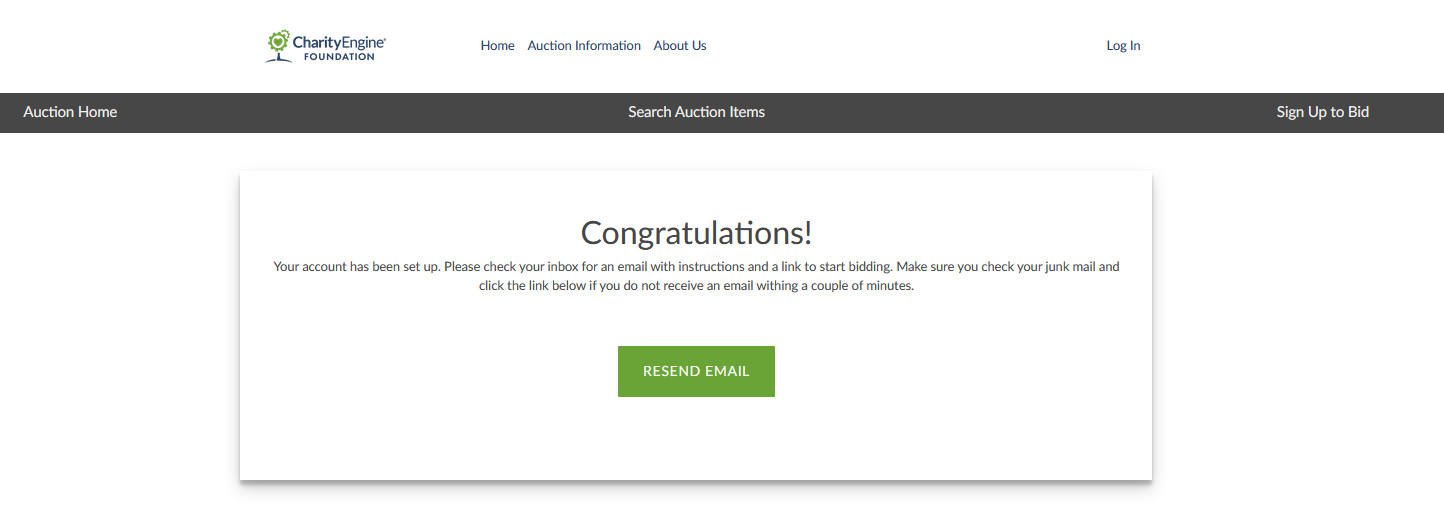
Email Example:
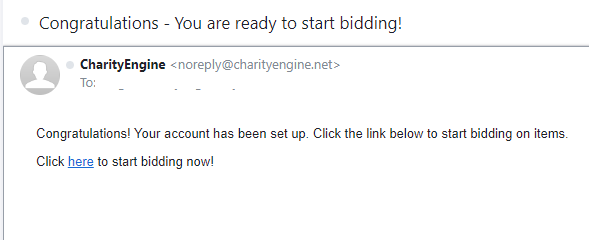
Previous/Existing Constituents
Returning constituents can also access prior auction enrollment information.
Step 1a: The constituent will enter their email address and password
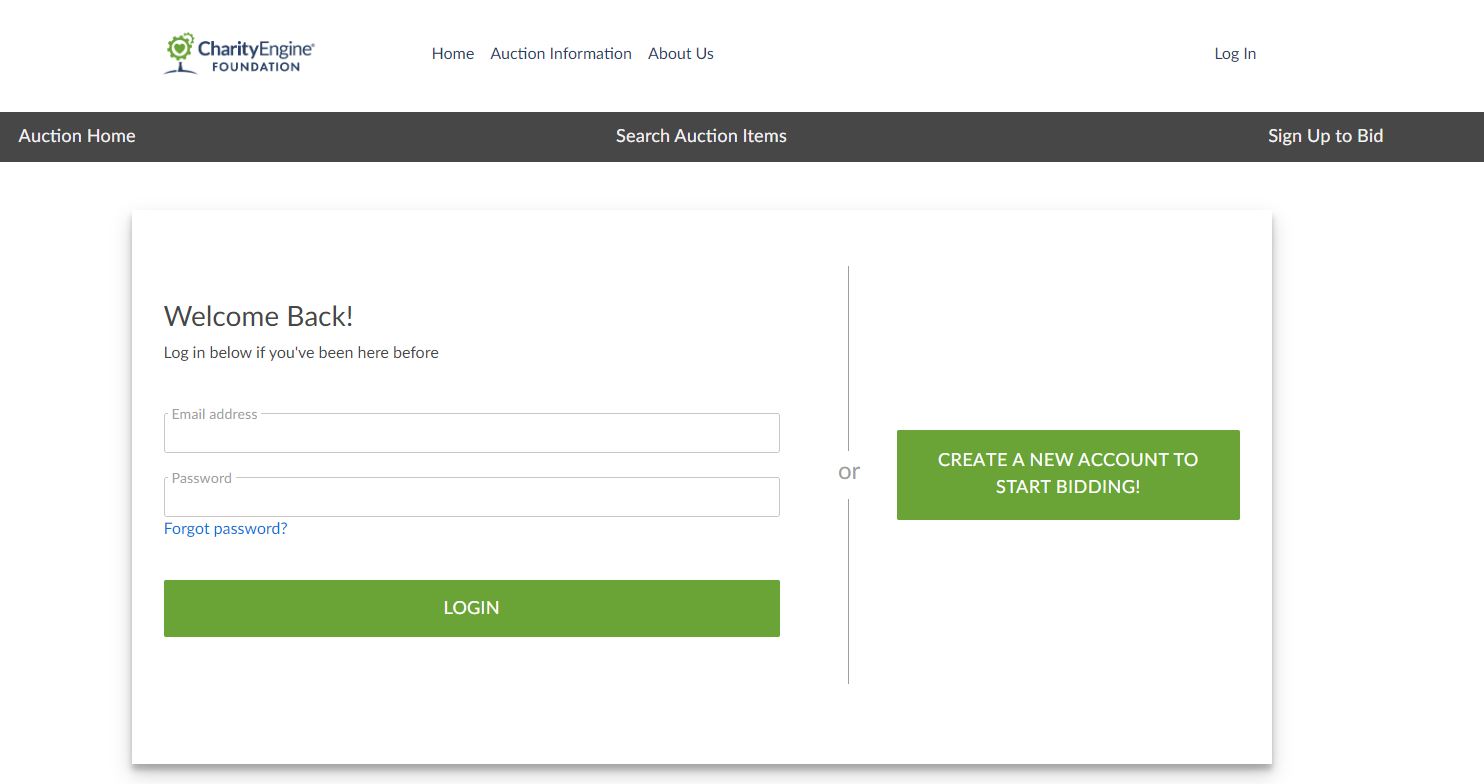
Step 1b: Forgot password - the constituent can also click on Forgot Password to navigate to the password reset workflow - including entry of the constituent's email address and clicking Reset Password

Manually Resetting a Constituent Password
As a user of CharityEngine, organizations can manually reset a consistent password.
Learn more in our article Contacts: Updating Donor Passwords
(Constituent) Profile
Constituents can also update payment information by accessing their profile from the navigation. Please note, the organization will need to expose the "Profile" via the Pages > Navigation section as outlined above.
In the example from this demonstration, "Profile" has been customized as "My Bidding Profile". By clicking this link, the user can update payment information for Credit Card or Bank Account (ACH).

Note: If the user has prior credentials for usage of Online User Center, Peer to Peer, etc., the user will be prompted for 2 factor authentication
Auction Site
Users have the ability to view detailed descriptions of auction items and update bid and automatic bid preferences

Users who have logged in have the ability to view prior bids:

User can manage payment information directly within their log in portal

Bidding Notification
Top Bidder Notification
Once a constituent completes a bid, the individual will receive notification via their registered email address and mobile number.

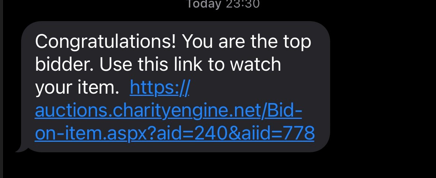
Links will route the bidder to the specific action item.
Outbid Notification
Once a constituent completes is outbid on an auction item, the individual will receive notification via their registered email address and mobile number.
Email Example:

SMS Example:

Links will route the bidder to the specific action item.
Auction Communication
If the organization has configured an Opt In list within the auction set up, organizations can quickly and easily send/schedule email blasts or SMS text blast (if available in the organization's account).
Leverage the Campaigns App > Quick Actions > Email Blast > Source: List > Select List: Organization's Auction Registration List
A similar action can take place using SMS Blast for text notifications
This will allow organizations to pre-schedule notifications or use a one off communication to auction participants.

Closing an Auction
Closing an action involves a few steps for winner notification, payment processing, and administrative closure activities.
Payment Processing - Charging Winners
Step 1: Navigate to Events App > Auctions > Winners
Step 2: From the Quick Filter, select the organization's Auction name
In this example, there is one contact within the Glow in the Dark Show auction. The contact is the winner of 2 items totaling $55.00

Step 3: The organization can use the check box to process winners by individual contact, or the user can use the check box to select all winners
Step 4: Once one or more contacts have been selected, use the carrot to expose the option to Charge Winners

Step 5: Select total record count to process, or all and click PROCESS

Step 6: Click OK on the Are you sure? prompt
Step 7: The user will receive a confirmation of processing at the top of the screen. As an additional confirmation, the user can verify the Balance column to show $0.00 due.
Note: Depending on total auction size, processing may take a few minutes to complete initiation of all transaction processing.

Additional Reporting can be located by navigating to the Events App > Auctions > Auction Items. Use the Quick Filter to select the Auction name and Paid = Yes
This example demonstrates the two auction items paid from example above.

Processing Note:
When closing an action item, not only with the winner be charged, but all prior bids will be processed. Authorizations will be reversed and void as an auction item is closed.
Notifying Winners - Send Messages
Prerequisite - Acknowledgement Template
Please complete an acknowledgement/receipt template via the Configuration App > Design & Message > Templates > Create New > Type: Receipt or Acknowledgement > Name > SAVE
Note: Individual emails will be delivered based upon the auction item. If a bidder has won more than 1 auction item, the bidder will receive an email confirmation for each item won.

From the Message Content tab, customize the message for winning auction bidders.
Use the Tokens option to insert transaction details and auction item details.

Acknowledging Winners
Step 1: Navigate to Events App > Auctions > Winners
Step 2: From the Quick Filter, select the organization's Auction name
In this example, there is one contact within the Glow in the Dark Show auction. The contact is the winner of 2 items totaling $120.50.

Step 3: The organization can use the check box to process winners by individual contact, or the user can use the check box to select all winners
Step 4: Once one or more contacts have been selected, use the carrot to expose the option to Send Messages

Step 5: From the pop-up, select:
- Delivery Method - Letter or Email
- Email Subject - if email, subject line
- Email Sender Name - if email, email sending name
- Email Reply-To - if email, organization's reply to address
- Create Activities - default no, adjust to yes if the organization wishes to create activities for each winning item and associated contact
Step 6: Select template and click SEND
Administrative Activities
When closing an auction, as a best practice, organizations should ensure the Event has been set with the appropriate end date. As an additional step, the organization can change the event to inactive.
Further, organizations can set auction items to inactive which will also deactivate items from display on the auction site.
Reporting
To access auction transactions, the organization can view all authorization attempts as well as final bid processing.
Step 1: Navigate to the Donations App > Transactions > Search & Manage > Advanced Filter
Step 2: Create appropriate filtering. Leverage the following advanced filters:
- To view "Auction" transactions navigate to: Advanced > Source = Auction
- To narrow auction transactions navigate to: Events & P2P > Events = Event name (if organization has multiple auction events)
- To view Authorizations vs. Confirmed payment navigate to: Payments > Show Auths = Yes and/or No
- Filter: No Authorized, Source = Auction, Event = event name
FAQs & Additional Reading
Q. How can I distinguish between authorized vs. pending transactions from the auction?
A. From Advanced Search, select "Show Auth" select NO to remove authorized transactions from the filter.
Q. Can you bid without a payment method?
A. No. Creating a payment method ensures verification of a bidder's financial ability to place bids on items in the auction. It involves temporarily holding a certain amount of funds or credit on the bidder's chosen payment method, usually a credit card, to ensure that they have the means to back up their bids if they win an item. This verification process helps prevent frivolous or fake bids and contributes to the integrity of the auction.
Q. What happens if the payment method fails at the closure of auction?
A. The organization may need to reach out to donor for an updated payment method if the transaction declines at the close of auction.
Q. If my donor won multiple items, will the donor be charged multiple times?
A. If multiple items purchased/won, payment processing and notification will result in separate transactions.
Q. When a user is accessing the bid history and we have activated the Show Names feature for bidding. The user is seeing bidder_######. Why is it not displaying the name of the current top bidder?
A. This will happen is the user has not logged into the auction site. This is an intentional design to limit donor/bidder details available for public view. Once a bidder logs into the auction site, the user will be able to see the top bidder name if this feature is activated.
Q. Can I add winners to a group, tag or list?
A. Yes, when looking at the winners you are able to bulk add winner to groups, tags, and list by selecting the winner you wish to add to the group and then selecting the bulk action button. You will see options "Add to Group", "Assign Tag" and "Add to Opt-In List".
